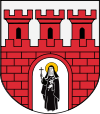 Alternate names: Skała [Pol], Skala [Yid, Rus], Скала [Rus], סקאלה [Heb]. 50°14' N, 19°52' E, 11 miles NNW of Kraków, 14 miles ESE of Olkusz. This is NOT the larger town of Skala Podolskaya, in Galicia]. 1900 Jewish population: 417. Jewish population: 1921 - 604. Skała is a town in southern Poland in Lesser Poland Voivodeship (since 1999), previously in Kraków Voivodeship (1975-1998).
Normal 0
Founded after 1862 on Krakow street, during WWII the Nazis destroyed 0.2-ha cemetery in a forest. Local municipal authorities have fenced the area in 1980. In the early 1990s, a Holocaust monument was erected.
Normal 0
Jewish settlement in Skala is not well documented, but probably was 1787. Initially, the Jewish community with two houses of prayer was subject to Olkusz kahal. The economic basis of the community was trade and crafts including tailoring; and some engaged manufacturing foodstuffs. During WWII, the Jews were subjected to repression and many deported to labor camps. At the end of August 1942 the remaining Jewish inhabitants deported to nearby Słomnik, went to Belzec after two weeks. Many just were killed here. Few survived the Holocaust, but the Majtelsów family hid with the Cerowie brothers. [July 2009]
Alternate names: Skała [Pol], Skala [Yid, Rus], Скала [Rus], סקאלה [Heb]. 50°14' N, 19°52' E, 11 miles NNW of Kraków, 14 miles ESE of Olkusz. This is NOT the larger town of Skala Podolskaya, in Galicia]. 1900 Jewish population: 417. Jewish population: 1921 - 604. Skała is a town in southern Poland in Lesser Poland Voivodeship (since 1999), previously in Kraków Voivodeship (1975-1998).
Normal 0
Founded after 1862 on Krakow street, during WWII the Nazis destroyed 0.2-ha cemetery in a forest. Local municipal authorities have fenced the area in 1980. In the early 1990s, a Holocaust monument was erected.
Normal 0
Jewish settlement in Skala is not well documented, but probably was 1787. Initially, the Jewish community with two houses of prayer was subject to Olkusz kahal. The economic basis of the community was trade and crafts including tailoring; and some engaged manufacturing foodstuffs. During WWII, the Jews were subjected to repression and many deported to labor camps. At the end of August 1942 the remaining Jewish inhabitants deported to nearby Słomnik, went to Belzec after two weeks. Many just were killed here. Few survived the Holocaust, but the Majtelsów family hid with the Cerowie brothers. [July 2009]
US Commission No. AS 183
The town is in Krakow region at 50º14N 19º51W, 29 km N of Cracow. The cemetery is on Krakowska St. (From Market Square, alongside Krakowska St., pass the Catholic cemetery. Go right and pass sport playgrounds of Sport Club "SK Skala".) Present town population is 1,000-5,000 with no Jews.
- Town: Urzad Miasta (City Council), 29 Rynek Sq., tel. 218308. Room 10. Local: Urzad Wojewodzki (Woivodship Office), Krakow, 22 Basztowa St., tel. 160200, fax no. 227208. Urzad Wojewodzki, Wydzial Spraw Spolecznych, (Woivodship Office, Dept. of Social Affairs) Krakow, 22 Basztowa St., tel. 226828, 223371 or 160268, Inspektor d/s Stowarzyszen i Wyznan (Inspectorate for Associations and Religious Denominations), Room 273. Additional the Kongregacja Wyznania Mojzeszowego (Jewish Congregation), 2 Skawinska St., Cracow, tel. 562349.
- Regional: Panstwowa Sluzba Ochrony Zabytkow, Wojewodzki Konserwator Zabytkow (State Preservation Authority, Conservation Officer for Woivodship) in Krakow, at 3 Wszystkich Swietych Sq., tel. 225977, fax 161417 (person dealing with cemeteries is 161415).
- Interested: 1. Regionalny Osrodek Studiow i Ochrony Krajobrazu, Kulturowego (Regional Center for the Study and Preservation of Cultural Landscape), Krakow. 2. Komitet Opieki nad Zabytkami Kultury Zydowskiej-sekcja Towarzystwa Milosnikow Historii i Zabtkow Krakowa (Committee for the Care of Monuments of Jewish Culture-section of Society of ? of History and Monuments of Cracow), 12 Swietego Jana St. Interested: Sad Wojewodzki-Wydzial Ksiag Wieczystych (Woivodship Court of Justice-Dept. of Land Record Books), Krakow, 7 Przy Rondzie St., tel. 114100 (Archive Room 119) and at Wojewodzkie Archiwum Panstwowe (State Archive for Woivodship) Krakow, 2 Sienna St., tel. 224094, and at the State Archive for Woivodship in Kielce.
The earliest known Jewish community is after 1862 because Jews were prohibited within the town's borders until 1862. 1921 Jewish population (census) was 604. The Jewish population was exterminated on 10 May 1943. Rabbi Awramin Dawidow Sztark lived here. The "local monument" cemetery was probably established after 1862 with last known Orthodox burial 1943. The isolated rural flat land has a Polish sign or plaque mentioning the Holocaust and the Jewish community. Reached by crossing private property, access is open to all with a continuous fence and non-locking gate. Before World War II, the cemetery was approximately 0.5 ha, but now it is approximately 0.1812 ha. due to agriculture. The granite Hebrew and Polish inscribed gravestones are no longer visible. The cemetery contains unmarked mass graves. The municipality owns cemetery used as cemetery and for agriculture. Properties adjacent are agricultural. Rarely, private visitors stop. The cemetery was vandalized during World War II, but not in the last ten years. Around 1980, local authorities fixed the wall; in the beginning of the 1990's, they erected the monument. There are no structures. Occasionally authorities clear or clean. Security and pollution are moderate threats; vegetation is a threat.
Malgorzta Radolowicz, 37 Florianska St., Apt. 3, Krakow, completed survey using the Land Survey Chart at the local community council. She visited on July 20, 1995 and interviewed the City Land Surveyor, Mr. Marian Tarnowka and the officer responsibe for cemeteries at the City Council, Ms. Zofia Basoj, and elderly local residents including Tadeusz Jakubowicz.
